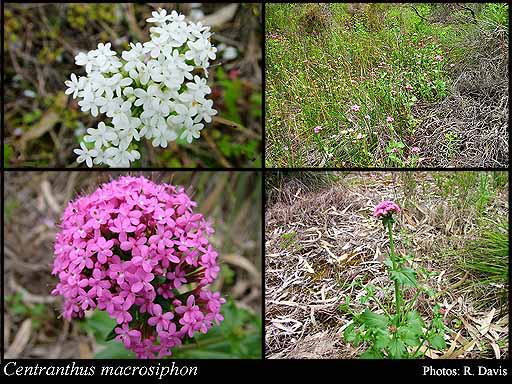- Reference
- Diagn.Pl.Orient. Ser. 1, Part 3:57 (1843)
- Conservation Code
- Not threatened
- Naturalised Status
- Alien to Western Australia
- Name Status
- Current
Erect annual, herb, (0.05-)0.1-0.4 m high. Fl. pink/pink-red/white, Aug to Nov. Grey sand over limestone. Disturbed areas.

Distribution
- IBRA Regions
- Jarrah Forest, Swan Coastal Plain.
- IBRA Subregions
- Northern Jarrah Forest, Perth, Southern Jarrah Forest.
- IMCRA Regions
- Leeuwin-Naturaliste.
- Local Government Areas (LGAs)
- Busselton, Cambridge, Capel, Collie, Cottesloe, Harvey, Mandurah, Mundaring, Murray, Nedlands, Northam, Perth, Rockingham, South Perth, Stirling, Subiaco, Swan, Waroona.
Management Notes (for the Swan NRM Region)
Alternative Names. Spanish Valerian.
General Biology. Growth form. Herb. Life form. Annual. Dispersal. Soil movement, garden waste, possibly wind and water. Seedbank persistence. Short, days-1 year.
Notes. Flowers are hermaphrodite (have both male and female parts) and are pollinated by bees, moths & butterflies. Prefers calcareous soils and has naturalised on roadsides and in tuart woodland where it can spread rapidly into undisturbed understorey vegetation.
Additional information. Origin. Northern Africa, southwestern Europe. History of use/introduction. Ornamental.
Suggested method of management and control. Hand remove small populations. Spray metsulfuron methyl at 0.1 g/15 L (2 g/ha) + wetting agent OR Logran® at 12.5 g/100L + the penetrant Pulse ® is very effective on adults and juveniles with little offtarget damage in coastal heathlands. Read the manufacturers' labels and material safety data sheets before using herbicides. For further information consult the Australian Pesticides and Veterinary Medicines Authority to determine the status of permits for your situation or state.
Management Calendar
| Calendar Type | Jan | Feb | Mar | Apr | May | Jun | Jul | Aug | Sep | Oct | Nov | Dec | Comments |
|---|---|---|---|---|---|---|---|---|---|---|---|---|---|
| Germination | Y | Y | Y | ||||||||||
| Active Growth | Y | Y | Y | Y | Y | O | |||||||
| Flowering | Y | Y | Y | Y | |||||||||
| Fruiting | Y | Y | Y | ||||||||||
| Manual Removal | Y | Y | Y | Y | Y | ||||||||
| Herbicide Treatment | Y | Y | Y |
Legend: Y = Yes, regularly, O = Occasionally, U = Uncertain, referred by others but not confirmed.
References
- Brown, K. & Brooks, K. (2002) Bushland Weeds: A Practical Guide to their Management. Environmental Weeds Action Network, Greenwood.
- Hussey, B.M.J., Keighery, G.J., Dodd, J., Lloyd, S.G. & Cousens, R.D. (2007) Western Weeds. A guide to the weeds of Western Australia. 2nd Edition. The Plant Protection Society of Western Australia, Victoria Park.
- Plants for a Future (Undated) Centranthus macrosiphon - Boiss. URL: http://www.pfaf.org/database/plants.php?Centranthus+macrosiphon - Accessed April 2010.
- Swarbrick, J.T. & Skarratt, D.B. (1994) The bushweed 2 database of environmental weeds in Australia. The University of Queensland, Gatton College.